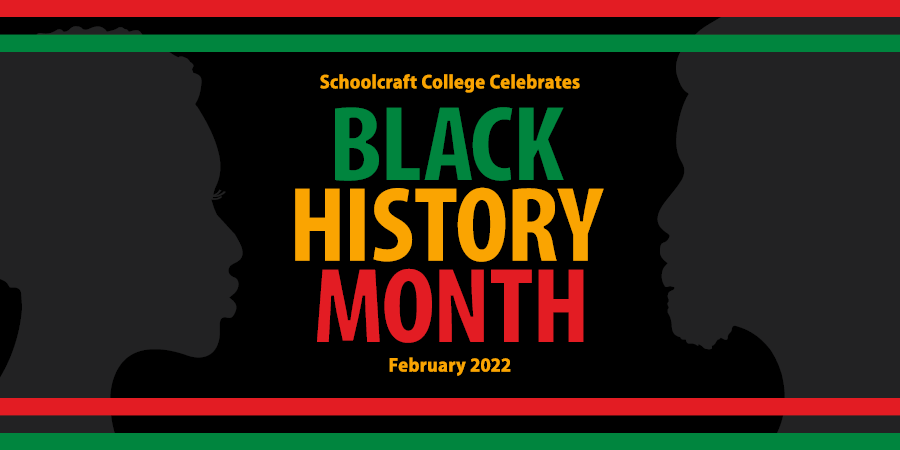Frederick Douglass
Frederick Augustus Washington Bailey was born into slavery on the Eastern Shore of Maryland in February 1818. He had a difficult family life. He barely knew his mother, who lived on a different plantation and died when he was a young child. He never discovered the identity of his father. When he turned 8 years old, his slaveowner hired him out to work as a body servant in Baltimore.
At an early age, Frederick realized there was a connection between literacy and freedom. Not allowed to attend school, he taught himself to read and write in the streets of Baltimore. At 12, he bought a book called The Columbian Orator. It was a collection of revolutionary speeches, debates, and writings on natural rights.
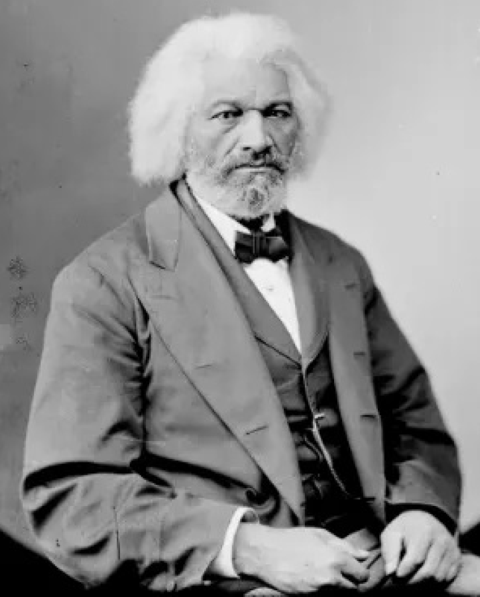
Photo 1 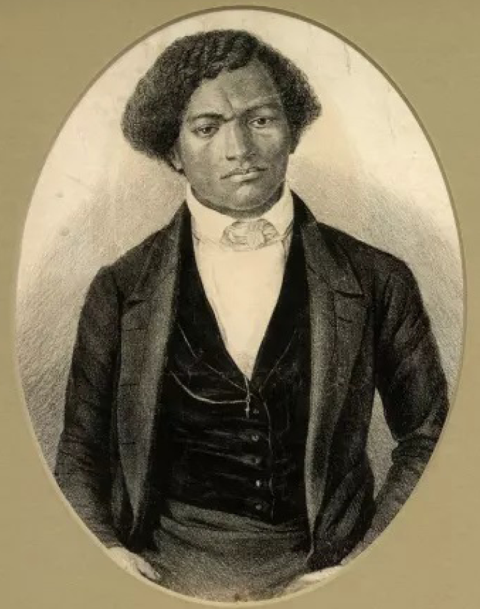
Photo 2
Photo 2: Frederick Douglass as a younger man.
When Frederick was 15, his slaveowner sent him back to the Eastern Shore to labor as a field hand. Frederick rebelled intensely. He educated other slaves, physically fought back against a “slave-breaker,” and plotted an unsuccessful escape.
Frustrated, his slaveowner returned him to Baltimore. This time, Frederick met a young free Black woman named Anna Murray, who agreed to help him escape. On September 3, 1838, he disguised himself as a sailor and boarded a northbound train, using money from Anna to pay for his ticket. In less than 24 hours, Frederick arrived in New York City and declared himself free. He had successfully escaped from slavery.
The Abolitionist Movement
After escaping, Frederick Douglass first lived at the Nathan and Polly Johnson house in New Bedford, Massachusetts. The home is now a National Historic Landmark.
After escaping from slavery, Frederick married Anna. They decided that New York City was not a safe place for Frederick to remain as a fugitive, so they settled in New Bedford, Massachusetts. There, they adopted the last name “Douglass” and they started their family, which would eventually grow to include five children: Rosetta, Lewis, Frederick, Charles, and Annie.
After finding employment as a laborer, Douglass began to attend abolitionist meetings and speak about his experiences in slavery. He soon gained a reputation as an orator, landing a job as an agent for the Massachusetts Anti-Slavery Society. The job took him on speaking tours across the North and Midwest.
Douglass’s fame as an orator increased as he traveled. Still, some of his audiences suspected he was not truly a fugitive slave. In 1845, he published his first autobiography, Narrative of the Life of Frederick Douglass, to lay those doubts to rest. The narrative gave a clear record of names and places from his enslavement.
To avoid being captured and re-enslaved, Douglass traveled overseas. For almost two years, he gave speeches and sold copies of his narrative in England, Ireland, and Scotland. When abolitionists offered to purchase his freedom, Douglass accepted and returned home to the United States legally free. He relocated Anna and their children to Rochester, New York.
In Rochester, Douglass took his work in new directions. He embraced the women’s rights movement, helped people on the Underground Railroad, and supported anti-slavery political parties. Once an ally of William Lloyd Garrison and his followers, Douglass started to work more closely with Gerrit Smith and John Brown. He bought a printing press and ran his own newspaper, The North Star. In 1855, he published his second autobiography, My Bondage and My Freedom, which expanded on his first autobiography and challenged racial segregation in the North.
Civil War and Reconstruction
In 1861, the nation erupted into civil war over the issue of slavery. Frederick Douglass worked tirelessly to make sure that emancipation would be one of the war’s outcomes. He recruited African American men to fight in the U.S. Army, including two of his own sons, who served in the famous 54th Massachusetts Volunteer Infantry. When Black troops protested they were not receiving pay and treatment equal to that of white troops, Douglass met with President Abraham Lincoln to advocate on their behalf.
As the Civil War progressed and emancipation seemed imminent, Douglass intensified the fight for equal citizenship. He argued that freedom would be empty if former slaves were not guaranteed the rights and protections of American citizens. A series of postwar amendments sought to make some of these tremendous changes. The 13th Amendment (ratified in 1865) abolished slavery, the 14th Amendment (ratified in 1868) granted national birthright citizenship, and the 15th Amendment (ratified in 1870) stated nobody could be denied voting rights on the basis of race, skin color, or previous servitude.
In 1872, the Douglasses moved to Washington, D.C. There were multiple reasons for their move: Douglass had been traveling frequently to the area ever since the Civil War, all three of their sons already lived in the federal district, and the old family home in Rochester had burned. A widely known public figure by the time of Reconstruction, Douglass started to hold prestigious offices, including assistant secretary of the Santo Domingo Commission, legislative council member of the D.C. Territorial Government, board member of Howard University, and president of the Freedman’s Bank.
Post-Reconstruction and Death
After the fall of Reconstruction, Frederick Douglass managed to retain high-ranking federal appointments. He served under five presidents as U.S. Marshal for D.C. (1877-1881), Recorder of Deeds for D.C. (1881-1886), and Minister Resident and Consul General to Haiti (1889-1891). Significantly, he held these positions at a time when violence and fraud severely restricted African American political activism.
On top of his federal work, Douglass kept a vigorous speaking tour schedule. His speeches continued to agitate for racial equality and women’s rights. In 1881, Douglass published his third autobiography, Life and Times of Frederick Douglass, which took a long view of his life’s work, the nation’s progress, and the work left to do. Although the nation had made great strides during Reconstruction, there was still injustice and a basic lack of freedom for many Americans.
Tragedy struck Douglass’s life in 1882 when Anna died from a stroke. He remarried in 1884 to Helen Pitts, an activist and the daughter of former abolitionists. The marriage stirred controversy, as Helen was white and 20 years younger than him. Part of their married life was spent abroad. They traveled to Europe and Africa in 1886-1887, and they took up temporary residence in Haiti during Douglass’s service there in 1889-1891.
On February 20, 1895, Douglass attended a meeting for the National Council of Women. He returned home to Cedar Hill in the late afternoon and was preparing to give a speech at a local church when he suffered a heart attack and passed away. Douglass was 77. He had remained a central figure in the fight for equality and justice for his entire life.
Harriet Tubman
Known as the “Moses of her people,” Harriet Tubman was enslaved, escaped, and helped others gain their freedom as a “conductor” of the Underground Railroad. Tubman also served as a scout, spy, guerrilla soldier, and nurse for the Union Army during the Civil War. She is considered the first African American woman to serve in the military.
Tubman’s exact birth date is unknown, but estimates place it between 1820 and 1822 in Dorchester County, Maryland. Born Araminta Ross, the daughter of Harriet Green and Benjamin Ross, Tubman had eight siblings. By age 5, Tubman’s owners rented her out to neighbors as a domestic servant. Early signs of her resistance to slavery and its abuses came at age 12 when she intervened to keep her master from beating an enslaved man who tried to escape. She was hit in the head with a 2-pound weight, leaving her with a lifetime of severe headaches and narcolepsy.
Although slaves were not legally allowed to marry, Tubman entered a marital union with John Tubman, a free Black man, in 1844. She took his name and dubbed herself Harriet.
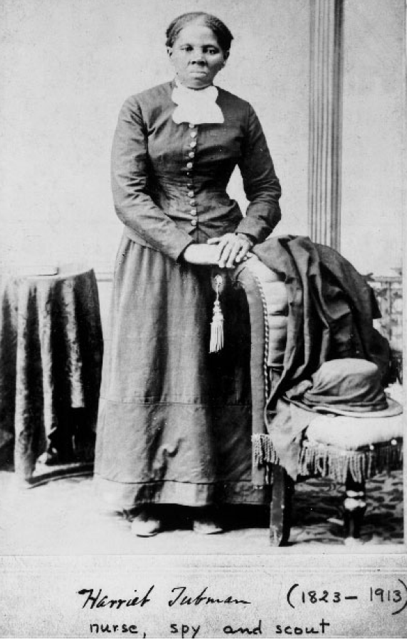
Photo 1 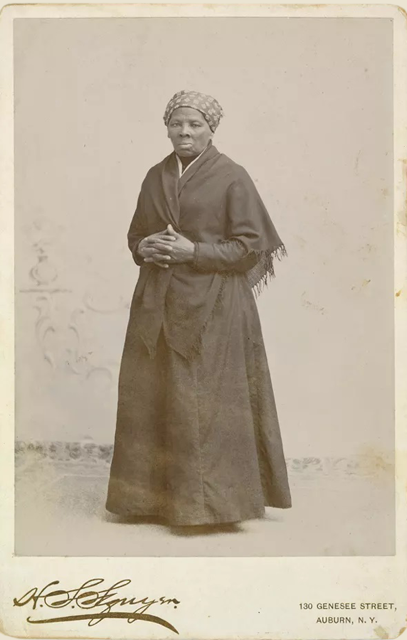
Photo 2
Photo 2: Harriet Tubman is considered the first African American woman to serve in the military.
Contrary to legend, Tubman did not create the Underground Railroad; it was established in the late 18th century by Black and white abolitionists. Tubman likely benefitted from this network of escape routes and safe houses in 1849, when she and two brothers escaped north. Her husband refused to join her, and by 1851 he had married a free Black woman. Tubman returned to the South several times and helped dozens of people escape. Her success led slaveowners to post a $40,000 reward for her capture or death.
Tubman was never caught and never lost a “passenger.” She participated in other antislavery efforts, including supporting John Brown in his failed 1859 raid on the Harpers Ferry, Virginia, arsenal.
Through the Underground Railroad, Tubman learned the towns and transportation routes characterizing the South—information that made her important to Union military commanders during the Civil War. As a Union spy and scout, Tubman often transformed herself into an aging woman. She would wander the streets under Confederate control and learn from the enslaved population about Confederate troop placements and supply lines. Tubman helped many of these individuals find food, shelter, and even jobs in the North. She also became a respected guerrilla operative. As a nurse, Tubman dispensed herbal remedies to Black and white soldiers dying from infection and disease.
After the war, Tubman raised funds to aid freedmen, joined Elizabeth Cady Stanton and Susan B. Anthony in their quest for women’s suffrage, cared for her aging parents, and worked with white writer Sarah Bradford on her autobiography as a potential source of income. She married a Union soldier Nelson Davis, also born into slavery, who was more than 20 years her junior.
Residing in Auburn, New York, she cared for the elderly in her home and in 1874, the Davises adopted a daughter. After an extensive campaign for a military pension, she was finally awarded $8 per month in 1895 as Davis’s widow (he died in 1888) and $20 in 1899 for her service. In 1896, she established the Harriet Tubman Home for the Aged on land near her home. Tubman died in 1913 and was buried with military honors at Fort Hill Cemetery in Auburn, New York.
Biography from womenshistory.org. Edited by Debra Michals, Ph.D., 2015
See more Black History content at schoolcraft.edu/BHM

